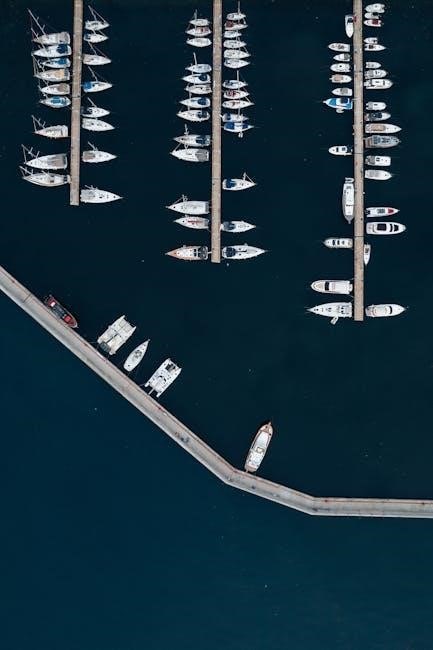Naval Ships Technical Manual 670 (TM 670) serves as a critical guide for naval operations, ensuring operational readiness, safety, and standardization across shipboard engineering practices and maintenance protocols.
1.1 Purpose and Scope of TM 670
Naval Ships Technical Manual 670 (TM 670) is designed to provide standardized engineering practices and guidelines for the maintenance, repair, and operation of naval vessels. Its primary purpose is to ensure operational efficiency, safety, and compliance with naval regulations. The manual covers a wide range of topics, including shipboard systems, safety protocols, and technical specifications. It serves as an authoritative guide for personnel, ensuring consistency and adherence to best practices across all naval operations. The scope of TM 670 is comprehensive, addressing both routine and complex engineering challenges.
1.2 Historical Background and Development
Naval Ships Technical Manual 670 (TM 670) has its roots in the need for standardized practices across naval operations. Initially developed to address the complexity of shipboard engineering, TM 670 evolved to incorporate advancements in technology and safety protocols. Historical iterations of the manual have been refined to reflect changing operational demands, ensuring its relevance in modern naval environments. The manual’s development has been shaped by lessons learned from past operations, making it a cornerstone of naval engineering and maintenance practices.
1.3 Importance of Standardization in Naval Operations
Standardization is paramount in naval operations to ensure consistency, safety, and efficiency. TM 670 establishes uniform engineering and maintenance practices, reducing errors and enhancing operational readiness. By adhering to standardized protocols, naval personnel can perform tasks with precision and reliability. This consistency also facilitates crew training and ensures compliance with safety regulations. Standardization fosters a culture of accountability and preparedness, enabling naval ships to operate effectively in diverse and challenging environments. It serves as the foundation for continuous improvement and innovation in naval engineering and maintenance practices.

Structure and Organization of TM 670
TM 670 is organized into comprehensive volumes, each focusing on specific aspects of naval engineering, ensuring clarity and accessibility for crew members and technicians alike.
2.1 Volume Breakdown and Content Organization
TM 670 is divided into multiple volumes, each addressing specific engineering domains such as propulsion, electrical systems, and maintenance. The content is meticulously organized, with chapters and sections clearly defined to ensure easy navigation. Each volume includes detailed appendices with supplementary materials like diagrams, checklists, and technical specifications. This structured approach allows crew members and technicians to quickly locate relevant information, enhancing efficiency and adherence to standardized procedures.
2.2 Key Chapters and Their Focus Areas
TM 670 contains key chapters dedicated to specific operational and technical aspects of naval ships. These chapters cover critical areas such as safety protocols, emergency procedures, and maintenance guidelines. One chapter focuses on propulsion systems, detailing their operation and repair. Another emphasizes electrical systems, ensuring power distribution and stability. A dedicated section on environmental compliance outlines sustainable practices. These chapters are designed to provide crew members with clear, actionable guidance, ensuring seamless operations and adherence to naval standards.
2.3 Cross-Referencing and Interconnectedness of Sections
TM 670 is structured to ensure seamless cross-referencing between sections, allowing users to navigate effortlessly through interconnected topics. This design enhances understanding by linking related procedures, safety protocols, and technical specifications. Each chapter includes references to relevant sections, reducing redundancy and improving efficiency. Visual aids, such as diagrams and flowcharts, further support the interconnectedness, making complex information accessible. This systematic approach ensures that crew members can quickly locate and apply critical information, fostering operational efficiency and compliance with naval standards.

Safety Standards and Operational Readiness
TM 670 establishes comprehensive safety standards and operational readiness guidelines, ensuring naval vessels function securely and efficiently under various conditions.
3.1 Safety Protocols for Shipboard Engineering
TM 670 outlines rigorous safety protocols for shipboard engineering, emphasizing adherence to standardized procedures, emergency preparedness, and regular equipment inspections. These protocols ensure crew safety, prevent operational hazards, and maintain vessel integrity. The manual also details contingency plans for unexpected incidents, ensuring timely and effective responses. By following these guidelines, naval personnel can mitigate risks and uphold the highest safety standards during engineering operations. The manual’s focus on proactive measures and clear communication pathways underscores its critical role in safeguarding both personnel and equipment.
3.2 Emergency Procedures and Contingency Planning
TM 670 provides detailed emergency procedures and contingency plans to address critical situations at sea. It includes step-by-step guidelines for system failures, fires, and environmental hazards, ensuring crew preparedness. The manual emphasizes rapid decision-making and coordinated responses to minimize damage and ensure safety. Regular drills and training are mandated to familiarize personnel with these protocols. By integrating contingency planning into daily operations, TM 670 enhances the navy’s ability to handle unforeseen challenges effectively, safeguarding both personnel and vessels in high-stress scenarios.
3.3 Role of TM 670 in Ensuring Operational Safety
TM 670 plays a pivotal role in ensuring operational safety by providing standardized protocols and guidelines for naval shipboard engineering. It establishes clear procedures for equipment operation, maintenance, and emergency response, reducing risks and enhancing crew safety. The manual’s comprehensive approach ensures compliance with safety regulations, fostering a culture of preparedness and accountability. By adhering to TM 670, naval personnel can maintain operational readiness while minimizing hazards, ultimately safeguarding both personnel and assets at sea.

Maintenance and Repair Guidelines
The Maintenance and Repair Guidelines section of TM 670 is a cornerstone for ensuring naval vessels’ longevity and efficiency. It outlines detailed procedures for scheduled maintenance, troubleshooting, and corrective actions, emphasizing the use of authorized tools and adherence to strict safety protocols to ensure operational readiness and safety at sea.
4.1 Scheduled Maintenance Procedures
Scheduled maintenance procedures in TM 670 are designed to ensure the longevity and optimal performance of naval ship systems. Regular inspections, lubrication schedules, and part replacements are meticulously outlined to prevent equipment degradation. These procedures are structured around maintenance cycles, ensuring that critical systems remain operational under various conditions. Adherence to these schedules is vital for maintaining readiness and safety. The manual also emphasizes the importance of documenting maintenance activities for compliance and audit purposes, ensuring transparency and accountability in upkeep processes.
4.2 Troubleshooting and Corrective Maintenance
Troubleshooting and corrective maintenance are essential components of TM 670, providing detailed procedures for identifying and resolving equipment malfunctions. The manual outlines a systematic approach to diagnosing issues, emphasizing root cause analysis to prevent recurring problems. It includes step-by-step repair guidelines, tools, and techniques to restore systems to operational status. These procedures ensure minimal downtime, enhancing operational readiness and safety. By addressing faults promptly and effectively, TM 670 supports the reliability and efficiency of naval shipboard engineering systems, aligning with the broader goals of the manual.
4.3 Tools and Equipment Specifications
TM 670 provides detailed specifications for tools and equipment essential for shipboard engineering and maintenance. It outlines the required tools, their calibration, and proper usage to ensure precision and safety. The manual emphasizes the importance of using approved equipment to meet naval standards. Compliance with these specifications ensures efficient and safe operations. Additionally, TM 670 offers guidelines for tool maintenance and replacement, fostering a culture of preparedness and reliability within naval ship operations. These standards are crucial for maintaining operational readiness and adherence to safety protocols.

Compliance and Regulatory Adherence
TM 670 ensures adherence to naval and international maritime regulations, providing guidelines for documentation, audits, and operational standards to maintain legal and safety compliance across all shipboard activities.
5.1 Naval Ship Safety Standards and Regulations
TM 670 outlines stringent safety standards and regulations for naval ships, ensuring compliance with international maritime laws and operational readiness. It incorporates guidelines from SOLAS and MARPOL to mitigate risks and enhance crew safety. The manual emphasizes adherence to documented protocols for emergency preparedness, environmental protection, and equipment maintenance. By aligning with global maritime regulations, TM 670 ensures that naval vessels operate safely and efficiently, meeting both national and international safety benchmarks.
5;2 Compliance with International Maritime Laws
TM 670 ensures adherence to international maritime laws, such as SOLAS and MARPOL, by providing standardized operational guidelines. This compliance is crucial for environmental protection, safety, and legal adherence. The manual incorporates global maritime regulations, ensuring naval ships meet international standards for emissions, waste management, and safety protocols. By aligning with these laws, TM 670 facilitates seamless integration of naval operations within the global maritime community, ensuring both operational efficiency and legal compliance.
5.3 Documentation Requirements for Audits
TM 670 outlines detailed documentation requirements to ensure compliance during audits. Accurate record-keeping of maintenance, inspections, and operational procedures is essential. The manual specifies the types of documents needed, such as logs, certificates, and reports, to demonstrate adherence to safety and regulatory standards. Proper documentation ensures transparency and accountability, facilitating smooth audits and maintaining operational integrity. Adherence to these requirements is critical for achieving certification and avoiding legal or operational repercussions.

Training and Crew Education
Training and Crew Education are vital for naval readiness. TM 670 provides structured programs, certification requirements, and emphasizes continuous professional development to ensure crew competency and safety.
6.1 Training Programs Based on TM 670
Training programs based on TM 670 are designed to enhance crew proficiency in shipboard engineering and maintenance, ensuring operational readiness. These programs emphasize hands-on experience, theoretical knowledge, and adherence to safety protocols. They cover diagnostic techniques, equipment operation, and emergency procedures, with a focus on practical exercises and real-world scenarios. Continuous updates align the training with technological advancements and operational requirements, ensuring crews are well-prepared for modern challenges. Such structured training fosters a highly competent workforce, essential for the safe and efficient operation of naval vessels.
6.2 Crew Certification and Competency Requirements
Crew certification and competency requirements are crucial for ensuring operational readiness and safety. TM 670 outlines specific standards that personnel must meet, including theoretical knowledge and practical skills. Certifications are granted upon successful completion of training and assessments, ensuring proficiency in shipboard engineering tasks. Compliance with these requirements is mandatory, and periodic evaluations are conducted to maintain competency levels. Adherence to TM 670’s guidelines ensures that crew members are adequately prepared to handle their responsibilities effectively, contributing to the overall operational safety and readiness of naval vessels.
6.3 Continuous Professional Development
Continuous professional development (CPD) is essential for maintaining crew proficiency and adapting to evolving technologies. TM 670 emphasizes ongoing training through workshops, seminars, and e-learning platforms, ensuring personnel stay updated on the latest engineering practices. Regular refresher courses and hands-on exercises reinforce theoretical knowledge, enhancing problem-solving skills and operational readiness. By fostering a culture of lifelong learning, TM 670 supports the professional growth of crew members, ensuring they remain competent in addressing complex challenges and advancing naval operations effectively.

Technical Specifications and Innovations
TM 670 integrates advanced engineering practices and modern technologies, ensuring naval ships operate with cutting-edge innovations. It emphasizes automation, sustainable systems, and adaptive solutions for future challenges.
7.1 Advanced Engineering Practices in TM 670
TM 670 incorporates advanced engineering practices, emphasizing automation, fuel efficiency, and sustainable systems. It promotes innovative solutions for shipboard operations, ensuring adaptability to future challenges while maintaining operational excellence and safety. These practices are designed to optimize performance, reduce environmental impact, and enhance the reliability of naval vessels in diverse mission scenarios; By integrating cutting-edge technologies, TM 670 sets a benchmark for modern naval engineering, fostering continuous improvement and readiness.
7.2 Integration of Modern Technologies
TM 670 emphasizes the integration of modern technologies to enhance operational readiness and efficiency. It covers advancements in automation, fuel-efficient systems, and sustainable practices. The manual highlights the use of smart sensors, AI-driven diagnostics, and real-time monitoring tools to optimize shipboard operations. These technologies ensure improved performance, reduced environmental impact, and enhanced safety. By aligning with cutting-edge innovations, TM 670 supports the evolution of naval engineering, enabling ships to meet current and future operational demands effectively.
7.3 Case Studies of Successful Implementations
TM 670 has been instrumental in numerous successful implementations across naval vessels, showcasing its practical application and effectiveness. Case studies highlight how adherence to its guidelines has improved operational readiness, reduced maintenance downtime, and enhanced safety. For instance, the integration of advanced diagnostic tools, as outlined in TM 670, has led to faster troubleshooting and corrective actions. These real-world examples demonstrate the manual’s role in driving efficiency, ensuring compliance with safety standards, and supporting the overall performance of naval ships in diverse operational environments.

Environmental and Operational Considerations
TM 670 emphasizes environmental impact assessments, fuel efficiency, and sustainability practices, ensuring operational readiness across diverse marine environments while minimizing ecological footprint and optimizing performance.
8.1 Environmental Impact Assessments
TM 670 outlines comprehensive environmental impact assessments to ensure naval operations align with ecological preservation. It emphasizes evaluating operational effects on marine ecosystems, promoting sustainable practices, and adhering to international environmental regulations. The manual provides guidelines for minimizing pollution, reducing waste, and optimizing fuel efficiency to lower carbon footprints. By integrating environmental stewardship, TM 670 supports operational readiness while safeguarding marine biodiversity and promoting responsible naval practices globally.
8.2 Fuel Efficiency and Sustainability Practices
TM 670 emphasizes fuel efficiency and sustainability as critical components of modern naval operations. It provides detailed guidelines for optimizing fuel consumption, reducing emissions, and implementing eco-friendly practices. The manual advocates for the use of advanced technologies and alternative energy sources to enhance operational sustainability. By prioritizing fuel efficiency, naval ships can reduce their environmental footprint while maintaining mission readiness. These practices align with global sustainability goals, ensuring naval operations remain both effective and environmentally responsible.
8.3 Operational Readiness in Various Environments
TM 670 ensures naval ships maintain peak operational readiness across diverse environments, from arctic to tropical zones. The manual outlines adaptive strategies for varying conditions, ensuring uninterrupted performance. It addresses environmental challenges, such as extreme temperatures and weather, providing tailored solutions. By adhering to TM 670, crews can navigate any operational theater efficiently, safeguarding mission success and crew safety. This adaptability is crucial for global naval operations, ensuring readiness in every scenario. The manual’s comprehensive approach guarantees sustained effectiveness regardless of environmental demands.

Appendices and References
The appendices and references in TM 670 provide supplementary materials such as charts, diagrams, and a glossary of terms. They also include a detailed bibliography for further reading, enhancing the manual’s practical application and ensuring comprehensive understanding.
9.1 Supplementary Materials and Resources
Section 9.1 of TM 670 offers a wealth of supplementary materials, including technical diagrams, charts, and detailed appendices. These resources are designed to support the manual’s guidelines, providing visual aids for complex procedures. Additionally, the section includes references to external documents and standards, ensuring users have access to a comprehensive suite of tools. These materials are essential for both training and operational purposes, making TM 670 an indispensable resource for naval personnel.
9.2 Glossary of Terms and Abbreviations
This section provides a comprehensive glossary of terms and abbreviations used throughout TM 670, ensuring clarity for all users. It defines technical jargon, acronyms, and specialized naval terminology, making the manual accessible to both experienced personnel and newcomers. The glossary is organized alphabetically, offering concise and precise definitions. For example, terms like “ENS” (Engineering Duty Officer) and “NVR” (Naval Vessel Register) are clearly explained. This resource enhances the manual’s usability, ensuring consistent understanding across all levels of naval operations.
9.3 Bibliography and Further Reading
This section lists all primary and secondary sources referenced in TM 670, ensuring academic integrity and providing readers with resources for deeper exploration. It includes technical manuals, academic papers, official naval documents, and industry standards. The bibliography is organized by topic and publication date, making it easy to locate relevant materials. Additional reading recommendations are also provided to support ongoing education and advanced understanding of naval engineering practices. This comprehensive list acts as a gateway for further research and professional development in naval operations.

TM 670 is a vital resource for naval operations, ensuring safety, standardization, and operational readiness. Its comprehensive guidance makes it an indispensable tool for the naval community.
10.1 Summary of Key Takeaways
Naval Ships Technical Manual 670 (TM 670) is a foundational document ensuring operational readiness, safety, and standardization in naval operations. It provides detailed guidelines for maintenance, repair, and compliance with safety protocols. The manual emphasizes the importance of crew training and continuous professional development to uphold competency standards. By integrating advanced engineering practices and modern technologies, TM 670 supports sustainable and efficient naval operations. Its comprehensive approach ensures adherence to international maritime laws and environmental considerations, making it an indispensable resource for the naval community.
10.2 Future Developments and Updates
Future revisions of TM 670 will focus on integrating cutting-edge technologies and addressing emerging challenges in naval operations. Updates will include advanced engineering practices, sustainability initiatives, and enhanced safety protocols. The manual will likely incorporate artificial intelligence and IoT for improved operational efficiency. Additionally, updates will reflect evolving international maritime regulations and environmental standards. Continuous feedback from naval personnel will guide these developments, ensuring TM 670 remains a vital and adaptive resource for modern naval operations, supporting innovation and readiness in a changing global landscape.
10.3 Final Thoughts on the Importance of TM 670
Naval Ships Technical Manual 670 stands as a foundational resource for modern naval operations, ensuring safety, efficiency, and compliance. Its comprehensive guidance supports crew training, maintenance, and emergency preparedness, making it indispensable for operational readiness. By adhering to TM 670, naval personnel uphold the highest standards of engineering and technical excellence. As naval operations evolve, TM 670 will remain a cornerstone, adapting to new challenges while maintaining its critical role in safeguarding lives and equipment. Its significance underscores the importance of standardized practices in achieving mission success.
